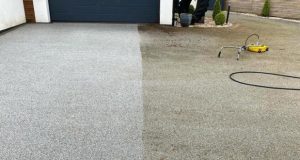On average a single workplace injury case can cost a business around £8,700 in lost time and medical fees, therefore it is hardly surprising that many companies are looking for ways to improve the general health of their workforce to reduce this risk. However, instigating new measures to prevent injury will often involve time-consuming and costly research and training processes, so finding methods that improve health and safety quickly and easily is a high priority.
 Like many other sectors that involve manual labour, the window cleaning industry is strictly controlled by regulations designed to ensure the safety of workers. Most recently the focus has been on improving the safety of those that work at height and reducing the need for workers to abseil or use ladders in multi-storey buildings. This has resulted in the ‘water-fed pole’ method being introduced, which allows cleaners to wash the upper floors of buildings using a long pole with a brush on the end and a water supply. Whilst this is an efficient and simple method that dramatically reduces the need for cleaners to work at height, there is a risk of injury to the lower back, shoulders and neck from repetitive movement.
Like many other sectors that involve manual labour, the window cleaning industry is strictly controlled by regulations designed to ensure the safety of workers. Most recently the focus has been on improving the safety of those that work at height and reducing the need for workers to abseil or use ladders in multi-storey buildings. This has resulted in the ‘water-fed pole’ method being introduced, which allows cleaners to wash the upper floors of buildings using a long pole with a brush on the end and a water supply. Whilst this is an efficient and simple method that dramatically reduces the need for cleaners to work at height, there is a risk of injury to the lower back, shoulders and neck from repetitive movement.
In recent years, advances in ergonomics have enabled us to take an in depth look at the effects of certain movements through HD video and sensors attached to various points of the body. This is particularly useful in identifying where there could be an issue for window cleaners that may use this technique for the next 10 to 15 years. At SWC we have teamed up with other leading window cleaning companies, the Health and Safety Executive, the Federation of Window Cleaners and leading ergonomics specialist dorsaVi to investigate the effects of the method and come up with ways to protect our workers in the long term.
The initial findings of the study were extremely interesting. Whilst a lot of people in the industry initially thought there would be an issue with damage to the lower back, the results revealed that the strain on the neck could actually be the biggest cause for concern. The next stage of the project will involve testing the effectiveness of different products, such as a neck support and reflective materials, to reduce the amount of time spent looking up. However, as with most tests, it is likely that it will take some time before we see the full results and these products become commonplace within the industry. In the meantime, there are a few simple things that window cleaning companies can do to help protect their workers that are using the ‘water-fed pole’ method.
Limiting time
One way of reducing the strain on the neck is by decreasing the amount of time window cleaners spend looking up. By limiting how long a cleaner uses the ‘water-fed pole’ method at any one time will ensure the worker can enjoy regular breaks and relax their neck muscles.
Personal care
Another approach that will help to reduce the effects on the body is to offer free advice to workers on the best way to look after their muscles. For example, inviting a personal trainer to run workshops on strength training and stretches that focus on the neck and upper body, or offering regular and free sports massages to help relieve tension and flag any potential issues early on.
The window cleaning industry, like many others, is experiencing a skills shortage. As a result, it has never been more important to make sure we take care of our workers to ensure they can have a long and successful career. Even though we are in the early stages of this study, and the full effects and solution are yet to be determined, there is no doubt that this will be good for the industry and the people within it.
By Gareth Thomas, Managing Director at SWC (Specialist Window Cleaning)




